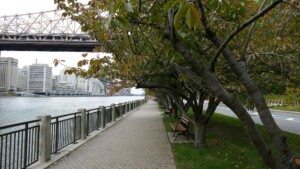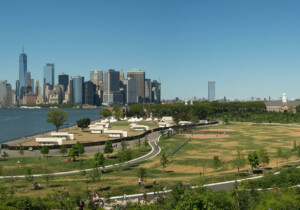Partisan political discourse still pretends as if there’s a climate change “debate,” yet the government is already acting extensively to prevent crises from rising global temperatures. Across the country, local and federal agencies are working with architects and planners to protect communities and redevelop neighborhoods in the aftermath of climate-related natural disasters. But what happens to residents who are too poor to get out of the way of storms—and too poor to return—and why is anyone rushing to live in disaster zones?
Catastrophic natural disasters share a common feature with accelerated processes of economic development: at vastly different rates, both can result in large-scale displacement. An article by Brentin Mock on environmental news site Grist uses a pithy phrase for the disparate impact climate change can have on lower-income residents: it’s the “ultimate gentrifier,” he wrote, citing the exodus of more than 300,000 low-income residents from New Orleans after Hurricane Katrina.
The description may be provocative, but studies by environmental scientists at the EPA’s Climate Change Division partly support the notion. Within the 6,000-square-mile area at high risk of flooding by 2100 due to a mid-range two-foot sea-level rise, almost 750,000 residents belong to the most socially vulnerable groups. These are most likely to be disproportionately impacted by storms and least likely to have the resources to move.
But are rich people really are moving into areas where low-income residents are being displaced by storms? Sadly, in some cases, yes. A New York Times story on high-rise condo construction in Sheepshead Bay, Brooklyn, reports that, far from retreating from flooded areas, a building boom is driving up prices.
Currently, local and federal agencies only spottily provide the necessary infrastructure and policy frameworks to protect against climate-related catastrophes ranging from forest fires in Southern California, earthquakes along the Pacific Coast, tornados and flash flooding in the Midwest, and hurricanes in the Gulf of Mexico. Adequate planning, federal aid, and environmental regulations can and should prevent disparate impacts of climate-change related severe weather events on low-income residents. In practice, prioritizing where to improve infrastructure falls to local governments that have worse financial constraints and often carry an implicit economic bias toward the most financially important areas.
In Alaska, higher temperatures are increasing erosion and thawing the permafrost, causing homes to sink in the mud. More than a dozen Inuit towns have already voted to move, including Newtok, which has acquired a relocation site through an act of Congress, and the 650-person Bering Sea village of Shishmaref, which commissioned AECOM’s Anchorage office to study the feasibility of relocation sites. Yet the cost of these moves, estimated at $214 million for Shishmaref alone, is far beyond the means of the inhabitants; a UN report on climate change and displacement notes the lack of state and federal governance structures to support these moves.
Some low-lying neighborhoods in New Orleans are undergoing a similar policy of unofficial abandonment, swallowed up by nature through neglect. These places are not gentrifying—they’re simply disappearing.
The Federal Emergency Management Agency (FEMA), reorganized in 2003 under the Department of Homeland Security and reformed since 2009 by Obama administration appointee Craig Fulgate, now talks about what it calls a “whole community” approach, emphasizing participation and engagement of a wide range of stakeholders. It needs to do more.
“FEMA has changed its rhetoric,” said Deborah Gans, who has conducted planning studies for low-lying neighborhoods in New Orleans and Red Hook, Brooklyn, most of which flooded in 2012 during Hurricane Sandy. “They don’t really know how to do it yet, but at least they’re talking the talk.”
In 2008, Homeland Security established the Regional Catastrophic Preparedness Grant program to encourage collaborative emergency planning in America’s ten largest urban regions. In New York’s combined statistical area, which includes New York, New Jersey, Pennsylvania, and Connecticut, the Regional Catastrophic Planning Team coordinated a series of Participatory Urban Planning workshops that included city and state agencies, nonprofits, community groups, private sector representatives, and even local Occupy affiliates to streamline emergency preparedness, housing recovery plans, and recovery processes in five types
of communities.
In the New York area, Hurricane Sandy has increased the sense of urgency. “In New York, about a third of our housing is within our six evacuation zones,” said Cynthia Barton, who participated in the workshops as manager of the Housing Recovery Program for the New York City Office of Emergency Management.
Barton leads the FEMA-supported initiative to prototype interim housing units, designed by James Garrison, which would substitute for the improvised mesh of hotels that sheltered displaced low-income residents in the aftermath of Sandy. The interim housing units, IKEA-like prefab condo boxes that stack up to three stories high in various configurations, facilitate an urban density allowing vulnerable residents to remain within their neighborhoods in the aftermath of severe storms.
“The basis for the project has always been that none of the federal temporary housing options would work in cities and that it’s very important to keep people close to home after a disaster,” Barton said. “In terms of economic stability for people and for neighborhoods, it’s important to keep people close to their jobs. It’s important for mental health reasons to keep people close to schools and close to their support networks.”
But on the federal level, long-term infrastructure improvements are not adequately funded. In New Orleans, landscape architect Susannah Drake of DLANDstudio is working on a gray and green streetscape program for 20 blocks of the St. Roch neighborhood. “The issue is that the base condition was low in terms of the infrastructure that existed,” Drake said. “We’re adding basic amenities for what would be a normal streetscape in New York, but we’re also dealing with the challenge of having very little infiltration and having a lot of water to manage…They’re not things the federal government is necessarily willing to pay for.”
Without federal insurance and public investment in infrastructure, wealthy homeowners don’t tend to move into flood zones. But storm protection, unevenly funded by federal grants, frequently has to be supported by local real-estate development tax revenues that provide lopsided advantages to upper-income residents.
“There’s a historical inequity environmentally in a lot of these neighborhoods in need, and it’s exacerbated by climate change,” said Gans, who led a Pratt Institute planning study on how to locate emergency housing in low-lying Red Hook, Brooklyn. “New York City Housing Authority projects were generally located on land that wasn’t that valuable, and guess what? It tended to be low-lying and out of the way.”
The problem centers on whether to save the threatened neighborhoods or rezone them to exclude residential use. Shoring up a city’s flood defenses can become an opportunity to improve a neighborhood’s environmental equity, but using the prevailing market-based model, focusing stormwater infrastructure in a waterfront community will only push more housing into vulnerable areas.
“As long as we keep allowing people to build market-rate waterfront property, there will be gentrification,” Gans said. “Any development that takes place on the water will be so expensive that it will necessarily gentrify the waterfront. There’s just no doubt about it.”
In Red Hook and Sunset Park, AECOM recently released a plan to place 30-50,000 units of new housing on the waterfront—25 percent of it affordable—as well as subsidize a new subway stop, and implement green and gray infrastructure for coastal protection and flood management. Arguing for the plan as a boost to Mayor de Blasio’s OneNYC ambition to build 200,000 affordable units by 2020, the proposal also runs counter to the idea of limiting exposure to areas of growing risk.
“Why would you build more housing in an area that’s underserved by transportation and that’s in a really dangerous zone, a flood area,” asked Drake, who designed the Sponge Park concept as a green infrastructure element for the Gowanus Canal. “I’m not an economist, but I’m very pragmatic and down on building in flood plains.”
Officially, there is no means testing of emergency planning or recovery aid. Eligibility for the National Flood Insurance Program and high insurance rates affect individual decision-makers. Not so for public housing, where residents’ lack of access to resources makes issues of planning that much more grave. Because of its 6,500 public housing residents, two-thirds of the Red Hook is below the poverty line. Economically, the light-manufacturing industries scattered among its low-rises generate relatively little revenue for the city to justify hundreds of millions in flood protection.
The conflict between access to revenues and local needs seems to underlie the rapidly advancing East Side and Lower Manhattan Coastal Resiliency projects, sections of Bjarke Ingels Group’s winning Rebuild by Design competition proposal for the protection of Lower Manhattan up to 59th Street. The projects essentially erect a wall adorned with parks as a bulwark against the sea. They implicitly prioritize the centrally important economic drivers of New York City.
“Ultimately there’s a cost-benefit analysis,” said Drake. “I’m not saying that lives are less valuable in other parts of the city, but when you do an economic cost-benefit analysis between Lower Manhattan and Red Hook, and you’re looking on purely financial terms, then Lower Manhattan wins because it’s an economic driver of the city.”
If it can really be done for that amount, the estimated cost for the Lower Manhattan projects is negligible in comparison to the economic benefit. The Office of Recovery and Resiliency and the Economic Development Corporation of New York have dedicated $100 million to an integrated flood protection system (IFPS) for Red Hook. City capital is supporting a $109 million Raise Shorelines Citywide project that would mitigate sea level rise in Old Howard Beach, Gowanus Canal, East River Esplanade, Mott Basin, Canarsie, Norton Basin, and the North Shore of Coney Island Creek.
“Emergency planning should really be about future planning,” Gans said. “The way you avert an emergency is by making sure you have integrative future plans that don’t put people in harm’s way and mitigate all of the bad decisions you made historically.”
In contrast to the oblivious political climate change “debate,” local governments have already learned from recent extreme weather events that they need to act to improve their planning capacity and infrastructure. Federal agencies are also acting, putting limited resources into protecting against climate change-related disasters. Highly engineered solutions are possible, but they’re unwise as a long-term strategy in the absence of a leveling off of global temperatures and will be cost-prohibitive for low-income communities. Unless the next Congress is prepared to fund a national infrastructure program, the best way to equitably protect low-income residents will be to downzone vulnerable areas and build new public housing on higher ground. Otherwise, we’ll need to accept the fact that our celebrated revitalized waterfront is mainly for the rich.










